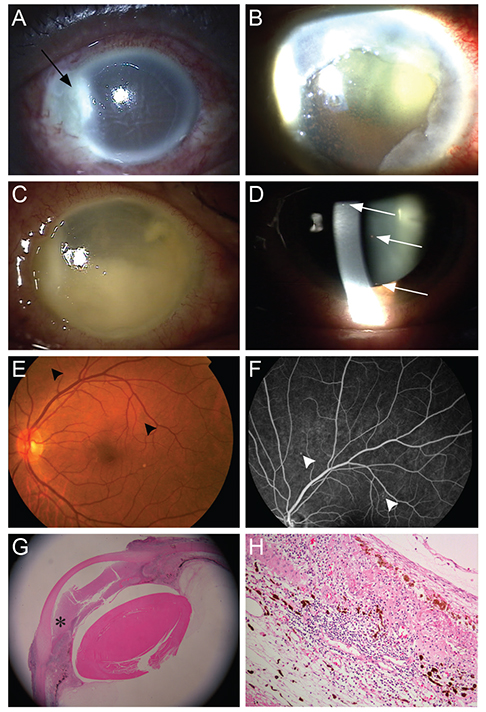Korean J Ophthalmol.
2015 Dec;29(6):435-436. 10.3341/kjo.2015.29.6.435.
Sympathetic Ophthalmia after Ocular Wasp Sting
- Affiliations
-
- 1Department of Ophthalmology, Kyungpook National University School of Medicine, Daegu, Korea.
- 2Department of Pathology, Kyungpook National University School of Medicine, Daegu, Korea.
- 3Department of Ophthalmology, Kyungpook National University School of Medicine, Daegu, Korea. okeye@knu.ac.kr
- KMID: 2363853
- DOI: http://doi.org/10.3341/kjo.2015.29.6.435
Abstract
- No abstract available.
MeSH Terms
-
Animals
Anti-Bacterial Agents
Antihypertensive Agents
Corneal Edema/diagnosis/etiology/therapy
Corneal Injuries/diagnosis/*etiology/therapy
Corneal Ulcer/diagnosis/etiology/therapy
Drug Combinations
Eye Enucleation
Eye Pain/etiology
Glaucoma/diagnosis/etiology/therapy
Glucocorticoids
Humans
Insect Bites and Stings/diagnosis/*etiology/therapy
Intraocular Pressure
Male
Middle Aged
Mydriatics
Ophthalmia, Sympathetic/diagnosis/*etiology/therapy
Visual Acuity
*Wasps
Anti-Bacterial Agents
Antihypertensive Agents
Drug Combinations
Glucocorticoids
Mydriatics
Figure
Reference
-
1. Gilboa M, Gdal-On M, Zonis S. Bee and wasp stings of the eye. Retained intralenticular wasp sting: a case report. Br J Ophthalmol. 1977; 61:662–664.2. Arcieri ES, Franca ET, de Oliveria HB, et al. Ocular lesions arising after stings by hymenopteran insects. Cornea. 2002; 21:328–330.3. Nakatani Y, Nishimura A, Sugiyama K. Successful treatment of corneal wasp sting-induced panuveitis with vitrectomy. J Ophthalmic Inflamm Infect. 2013; 3:18.4. Gurlu VP, Erda N. Corneal bee sting-induced endothelial changes. Cornea. 2006; 25:981–983.


